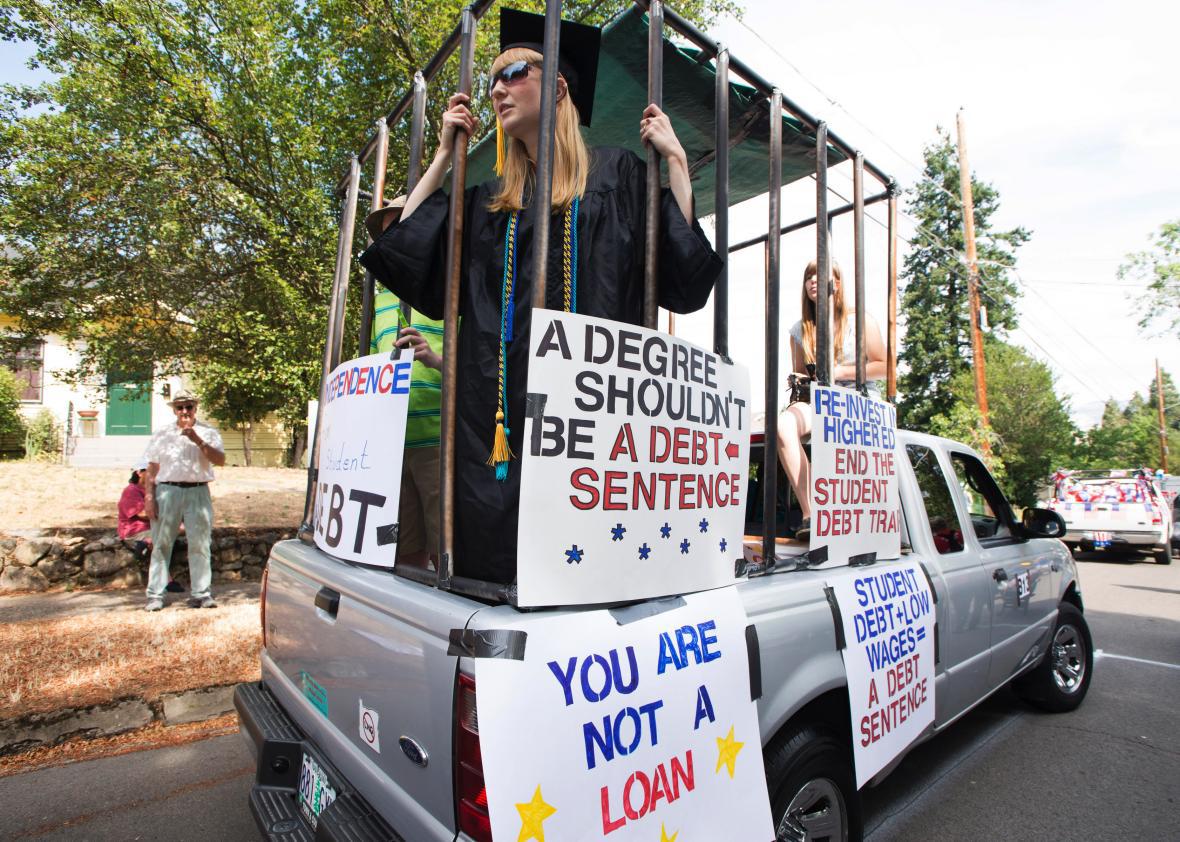An especially half-baked idea for dealing with America’s student debt burden has been bubbling up from the far reaches of the political left lately: Washington, a few well-meaning souls say, should just forgive all of the loans—wipe the slate clean. The Green Party’s Jill Stein is running for president on the promise that she’ll wave away every cent of outstanding federal education debt. And late last week, Bard College President Leon Botstein argued in Money that Hillary Clinton should vow to do the same, giving the concept at least a thin veneer of academic respectability.
It’s easy to see why this notion would be politically appealing for a certain kind of lefty. Many young progressives are college graduates with student loans they would love to see disappear. If you’re a third-party candidate like Jill Stein, appealing to their self-interest is an obvious way to attract a few votes. Meanwhile, if you’re the president of an expensive private institution of higher education, like Botstein is, a temporary solution to college costs that doesn’t require any sacrifice from universities themselves is probably very appealing. And, hey, student debt is a crushing, generational crisis, right? Why not just eliminate it all?
Well, for one thing, it would be expensive—there are about $1.25 trillion of outstanding federal loans right now, which is more than a year’s worth of Social Security spending, or enough to fund the federal block grant for Temporary Assistance for Needy Families, aka welfare, for about 78 years. But more importantly, across-the-board student-loan forgiveness would be an incredibly regressive way of dealing with debt. And typically, trillion-dollar spending programs that disproportionately benefit relatively affluent college graduates aren’t high on progressives’ to-do lists. Or they shouldn’t be, anyway.
Before I get into the details, it’s worth noting just how poorly thought-out both Stein’s and Botstein’s proposals are. Stein has suggested that the Federal Reserve could use quantitative easing to forgive student loans—a bizarre notion that seems to have been inspired by her complete misunderstanding of what quantitative easing actually is. But that’s a bit less embarrassing than Botstein’s grand proposal to eliminate the current student lending program and replace it with one that forgives a borrower’s debt if he or she works in public service for a period of time. Had he done a little basic Googling, the man would have learned that such a program already exists: It’s called—get ready for it— the Public Service Loan Forgiveness Program, and it actually erases debt after 10 years, instead of the 20 Botstein suggests. I just pray that Bard’s financial aid office is a little more read up on the issue.
But leave aside Botstein’s lack of basic familiarity with student lending as it now exists. Ignore Stein’s odd ideas about how we might deploy somewhat arcane monetary-policy tools. The bigger, conceptual problem with mass student debt forgiveness is that it would spend a whole lot of money while doing a very poor job targeting the people who need help.
The most important thing to realize about student loans is that most borrowers don’t have too much trouble handling them. In 1999, the median borrower would have had to spend about 5 percent of his or her income after leaving school to pay back loans. By 2010 that number had only risen to 6 percent. In 2014, Beth Akers of the Brookings Institution observed that the average student loan payment wasn’t much more than what the typical household laid out each month on entertainment. And while default rates have gone up significantly since the financial crisis, the problem has been concentrated overwhelmingly among students who attended for-profit colleges, who are often lower-income minorities. Students who drop out are also more likely to fall behind on their payments. In general, these troubled borrowers actually have smaller loan balances than those who are current on their debts.
The flip side of that fact is that a disproportionate amount of student-loan debt is sitting in the hands of relatively few borrowers—particularly former graduate students, who often make very decent salaries. In 2013, the top 20 percent of borrowers was shouldering 61 percent of all outstanding student loan debt. The highest earning 20 percent of borrowers, meanwhile, was carrying 36 percent of outstanding debt.
None of this should be surprising. Chances are that if you borrowed a bunch to get an MBA, you’re about to earn much more than, say, a young woman who left a regional public college after a few semesters and is now having trouble managing the $5,000 worth of Stafford Loans she took out. Forgiving all student loan debt in one giant swoop would hand a five- or even six-figure windfall to all those well-educated professionals, and much less to the struggling dropouts. We’d be spending a lot for the benefit of comfortable graduates in order to give a little help to some hard-pressed middle-class Americans. Ergo, it’s regressive.
Of course, we haven’t even touched the fact that, should the government turn up a spare $1.25 trillion, there might be better uses for it than forgiving student loans. You have to pick priorities, and while Botstein tries to get around that by saying forgiving student debt would also act as an economic stimulus, there are other ways to give the economy a one-time, $1.25 trillion shot in the arm; you could, for instance, just cut a check to every American, whether or not they were fortunate enough to ever go to college. Last I checked, high school graduates could use a hand these days, too.
